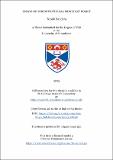Files in this item
Essays on unconventional monetary policy
Item metadata
| dc.contributor.advisor | Senay, Özge | |
| dc.contributor.advisor | Macmillan, Peter | |
| dc.contributor.author | Bandera, Nicolò | |
| dc.coverage.spatial | 239 | en_US |
| dc.date.accessioned | 2023-09-04T15:18:00Z | |
| dc.date.available | 2023-09-04T15:18:00Z | |
| dc.date.issued | 2023-11-28 | |
| dc.identifier.uri | https://hdl.handle.net/10023/28298 | |
| dc.description.abstract | This dissertation studies the synergies and trade-offs between unconventional monetary policy instruments and their interactions with macro-prudential policy. The complementarities between policy tools played a critical role in the monetary response to the Covid-19 pandemic, but they have been overlooked by the literature. My dissertation answers the call by policymakers to fill this knowledge gap undermining unconventional monetary policy (UMP) effectiveness. The first chapter assesses empirically the efficacy of the lending programmes in the context of the Chinese monetary policy. It finds that liquidity injections enhance the policy rate signal and are deployed in coordination with other policy tools – consistent with the European Central Bank’s (ECB) experience. The second and third chapters, are theoretical and extend a workhorse DSGE model nesting quantitative easing, negative interest rate policy and forward guidance along two dimensions. The second chapter adds macro-prudential policy to study how the introduction of a countercyclical capital buffer affects the transmission of UMP. Policy simulations show that deploying simultaneously macro-prudential policy and UMP strengthens the effectiveness of monetary policy and allows an earlier unwinding of UMP. The third chapter expands the baseline model with central bank lending programmes featuring a collateral policy and a “dual rate system”. It aims to analyse the interlinkages generated by the simultaneous deployment of the lending programmes with other UMP tools. Four channels of monetary transmission arise and the chapter offers policy recommendations to capitalise on the synergies and mitigate the trade-offs. The final chapter estimates the loss in Euro Area potential output due to the Covid-19 crisis using a novel sectoral method. It finds that potential output in 2025 might be 0.8% lower than in the absence of the Covid-19 crisis. | en_US |
| dc.language.iso | en | en_US |
| dc.relation | Bandera, N., Bodnár, K., Le Roux, J. and Szörfi, B. (2022), “The impact of the COVID-19 shock on euro area potential output: a sectoral approach”, Working Paper Series 2717, European Central Bank | en |
| dc.rights | Creative Commons Attribution-NonCommercial-NoDerivatives 4.0 International | * |
| dc.rights.uri | http://creativecommons.org/licenses/by-nc-nd/4.0/ | * |
| dc.subject | Monetary policy | en_US |
| dc.subject | Macro-prudential policy | en_US |
| dc.subject | Potential output | en_US |
| dc.subject | DSGE | en_US |
| dc.subject | Structural VAR | en_US |
| dc.subject.lcc | HG230.3B26 | |
| dc.subject.lcsh | Monetary policy | en |
| dc.title | Essays on unconventional monetary policy | en_US |
| dc.type | Thesis | en_US |
| dc.contributor.sponsor | University of St Andrews. School of Economics and Finance. George and Stella Lee Scholarship | en_US |
| dc.type.qualificationlevel | Doctoral | en_US |
| dc.type.qualificationname | PhD Doctor of Philosophy | en_US |
| dc.publisher.institution | The University of St Andrews | en_US |
| dc.identifier.doi | https://doi.org/10.17630/sta/600 |
The following licence files are associated with this item:
This item appears in the following Collection(s)
Except where otherwise noted within the work, this item's licence for re-use is described as Creative Commons Attribution-NonCommercial-NoDerivatives 4.0 International
Items in the St Andrews Research Repository are protected by copyright, with all rights reserved, unless otherwise indicated.


